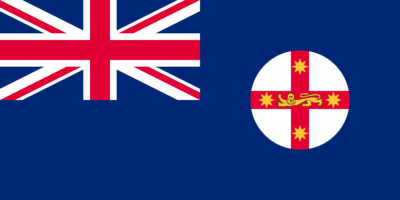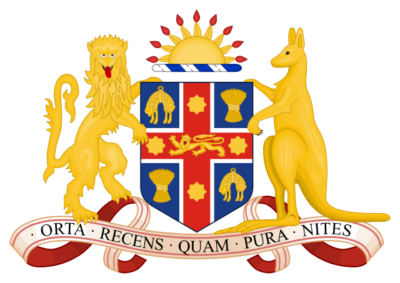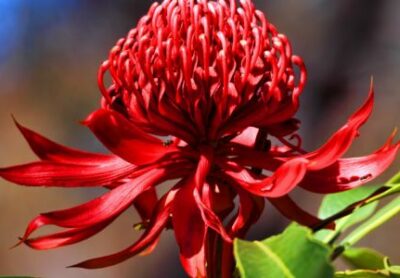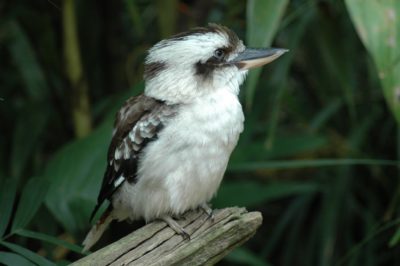NSW Flags & Emblems
On 15th February, 1876, a new badge was proclaimed in the New South Wales Government Gazette.
 The notice read: “His Excellency the Governor has been pleased, with the advice of the Executive Council, to direct that, for the future, the badge of the Colony to be emblazoned in the centre of the Union Jack used by the Governor when afloat, and to be inserted in the Blue Ensign by vessels in the employment of the Colonial Government, shall be as hereinafter described –
The notice read: “His Excellency the Governor has been pleased, with the advice of the Executive Council, to direct that, for the future, the badge of the Colony to be emblazoned in the centre of the Union Jack used by the Governor when afloat, and to be inserted in the Blue Ensign by vessels in the employment of the Colonial Government, shall be as hereinafter described –
Argent, on a cross gules a lion passant guardant or between four stars of eight points also or.. A free translation of this heraldic description is:
.On a silver background, a red cross bearing a golden lion in the centre and an eight pointed golden star on each arm..
New South Wales Coat of Arms
 King Edward VII approved the Coat of Arms in October 1906 with the following words: “Know ye therefore that We of Our Princely Grace and Special Favour have granted and assigned and by these Presents do grant and assign the following Armorial Ensigns and Supporters for the said State of New South Wales that is to say for Arms Azure a Cross Argent voided Gules charged in the centre chief point with a Lion passant guardant, and on each member with a Mullet of eight points Or between in the first and fourth quarters a Fleece of the last banded of the second and in the second and third quarters a Garb also Or: And for the ’Crest on a Wreath of the Coloursa Rising Sun each Ray tagged with a Flame of fire proper: And for the Supporters On the dexter side A Lion rampant guardant: And on the sinister side ’A Kangaroo both Or’,together with this Motto, ’Orta Recens Quam Pura Nites’.” The New South Wales State crest was gazetted on 18th February, 1876.
King Edward VII approved the Coat of Arms in October 1906 with the following words: “Know ye therefore that We of Our Princely Grace and Special Favour have granted and assigned and by these Presents do grant and assign the following Armorial Ensigns and Supporters for the said State of New South Wales that is to say for Arms Azure a Cross Argent voided Gules charged in the centre chief point with a Lion passant guardant, and on each member with a Mullet of eight points Or between in the first and fourth quarters a Fleece of the last banded of the second and in the second and third quarters a Garb also Or: And for the ’Crest on a Wreath of the Coloursa Rising Sun each Ray tagged with a Flame of fire proper: And for the Supporters On the dexter side A Lion rampant guardant: And on the sinister side ’A Kangaroo both Or’,together with this Motto, ’Orta Recens Quam Pura Nites’.” The New South Wales State crest was gazetted on 18th February, 1876.
The central red cross, in a larger silver cross, is the Red Cross of St George, the old badge of the Colony. It is also the Navy flag badge and so recognises the contribution to our discovery and development of the work of such naval officers as Captain Cook and Governors Philip, Hunter, King and Bligh.
The four stars on the cross represent the Southern Cross, from earliest time a mariner’s guide in the south and referred to so often in our poetry and literature as anational symbol. The lion in the centre is the English Lion derived from the British Arms. The first and fourth quarterings are the Golden Fleece, a reference to our great achievement in the wool industry. The second and third quarterings are the Wheat Sheaf, representing our second and great primary industry. The crest, the Rising Sun, continues the use of our earliest colonial crest, representative of a newly rising country. The livery colours of the Arms, blue and white, mirror the States sporting colours. The right hand supporter, the Lion is a further recognition of the British origin of our first settlers and the continuing connection between New South Wales and Great Britain. For the left hand supporter, the use of the kangaroo is self explanatory.
It is our most distinctive animal, restricted almost entirely to Australia and adopted so often as an emblem of Australia. The motto of New South Wales “Orta recens quam pura nites” may be translated “Newly risen how brightly you shine” and, like the rising sun in the crest, is representative of our continuing progress and development.

 The notice read: “His Excellency the Governor has been pleased, with the advice of the Executive Council, to direct that, for the future, the badge of the Colony to be emblazoned in the centre of the Union Jack used by the Governor when afloat, and to be inserted in the Blue Ensign by vessels in the employment of the Colonial Government, shall be as hereinafter described –
The notice read: “His Excellency the Governor has been pleased, with the advice of the Executive Council, to direct that, for the future, the badge of the Colony to be emblazoned in the centre of the Union Jack used by the Governor when afloat, and to be inserted in the Blue Ensign by vessels in the employment of the Colonial Government, shall be as hereinafter described – King Edward VII approved the Coat of Arms in October 1906 with the following words: “Know ye therefore that We of Our Princely Grace and Special Favour have granted and assigned and by these Presents do grant and assign the following Armorial Ensigns and Supporters for the said State of New South Wales that is to say for Arms Azure a Cross Argent voided Gules charged in the centre chief point with a Lion passant guardant, and on each member with a Mullet of eight points Or between in the first and fourth quarters a Fleece of the last banded of the second and in the second and third quarters a Garb also Or: And for the ’Crest on a Wreath of the Coloursa Rising Sun each Ray tagged with a Flame of fire proper: And for the Supporters On the dexter side A Lion rampant guardant: And on the sinister side ’A Kangaroo both Or’,together with this Motto, ’Orta Recens Quam Pura Nites’.” The New South Wales State crest was gazetted on 18th February, 1876.
King Edward VII approved the Coat of Arms in October 1906 with the following words: “Know ye therefore that We of Our Princely Grace and Special Favour have granted and assigned and by these Presents do grant and assign the following Armorial Ensigns and Supporters for the said State of New South Wales that is to say for Arms Azure a Cross Argent voided Gules charged in the centre chief point with a Lion passant guardant, and on each member with a Mullet of eight points Or between in the first and fourth quarters a Fleece of the last banded of the second and in the second and third quarters a Garb also Or: And for the ’Crest on a Wreath of the Coloursa Rising Sun each Ray tagged with a Flame of fire proper: And for the Supporters On the dexter side A Lion rampant guardant: And on the sinister side ’A Kangaroo both Or’,together with this Motto, ’Orta Recens Quam Pura Nites’.” The New South Wales State crest was gazetted on 18th February, 1876. The botanical name for this plant, which has been adopted as the Floral Emblem for New South Wales is (Telopea speciossima), which comes from the Greek “Telopos” – seen from afar; and “Speciossima” from the Latin – very beautiful. No one knows the meaning to the native name “Waratah”.
The botanical name for this plant, which has been adopted as the Floral Emblem for New South Wales is (Telopea speciossima), which comes from the Greek “Telopos” – seen from afar; and “Speciossima” from the Latin – very beautiful. No one knows the meaning to the native name “Waratah”. One of the most familiar sounds in the bush is the extraordinary chorus of laughter of the kookaburra or “Laughing Jackass” as it is sometimes called. It is usually heard in the morning and evening but also at any time through the day. The true function of this famous call is to advertise their territory. Unlike most of its kingfisher relatives, Kookaburras occupy the same patch of country all year round.
One of the most familiar sounds in the bush is the extraordinary chorus of laughter of the kookaburra or “Laughing Jackass” as it is sometimes called. It is usually heard in the morning and evening but also at any time through the day. The true function of this famous call is to advertise their territory. Unlike most of its kingfisher relatives, Kookaburras occupy the same patch of country all year round. Platypuses live in rivers and streams of eastern Australia as far north as Cape York in Queensland and south to Tasmania. They are one of the two egg-laying mammals or monotremes (the other is the echidna or spiny ant eater) which are only found in the Australasian region. They are well adapted for a life in water, since they have close, plush-like fur, a flattened tail and webbed feet.
Platypuses live in rivers and streams of eastern Australia as far north as Cape York in Queensland and south to Tasmania. They are one of the two egg-laying mammals or monotremes (the other is the echidna or spiny ant eater) which are only found in the Australasian region. They are well adapted for a life in water, since they have close, plush-like fur, a flattened tail and webbed feet.